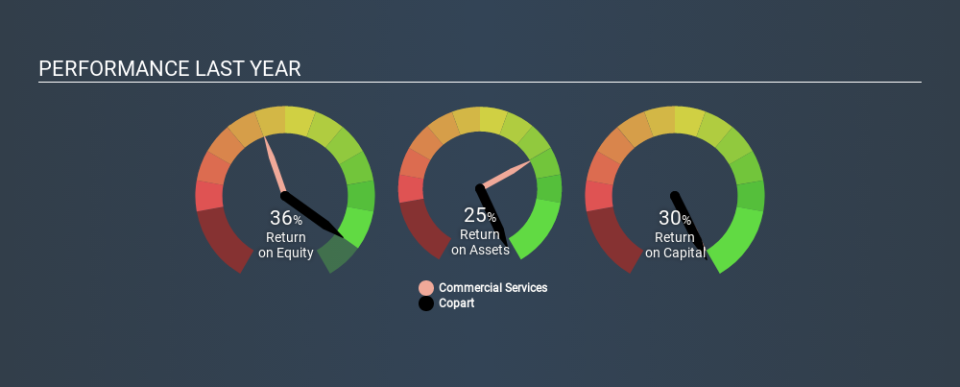Copart, Inc. (NASDAQ:CPRT) Earns Among The Best Returns In Its Industry

Today we are going to look at Copart, Inc. (NASDAQ:CPRT) to see whether it might be an attractive investment prospect. In particular, we'll consider its Return On Capital Employed (ROCE), as that can give us insight into how profitably the company is able to employ capital in its business.
Firstly, we'll go over how we calculate ROCE. Second, we'll look at its ROCE compared to similar companies. Finally, we'll look at how its current liabilities affect its ROCE.
Understanding Return On Capital Employed (ROCE)
ROCE is a metric for evaluating how much pre-tax income (in percentage terms) a company earns on the capital invested in its business. In general, businesses with a higher ROCE are usually better quality. In brief, it is a useful tool, but it is not without drawbacks. Author Edwin Whiting says to be careful when comparing the ROCE of different businesses, since 'No two businesses are exactly alike.
How Do You Calculate Return On Capital Employed?
The formula for calculating the return on capital employed is:
Return on Capital Employed = Earnings Before Interest and Tax (EBIT) ÷ (Total Assets - Current Liabilities)
Or for Copart:
0.30 = US$770m ÷ (US$2.9b - US$323m) (Based on the trailing twelve months to October 2019.)
So, Copart has an ROCE of 30%.
Check out our latest analysis for Copart
Does Copart Have A Good ROCE?
ROCE is commonly used for comparing the performance of similar businesses. Using our data, we find that Copart's ROCE is meaningfully better than the 9.4% average in the Commercial Services industry. I think that's good to see, since it implies the company is better than other companies at making the most of its capital. Setting aside the comparison to its industry for a moment, Copart's ROCE in absolute terms currently looks quite high.
The image below shows how Copart's ROCE compares to its industry, and you can click it to see more detail on its past growth.
Remember that this metric is backwards looking - it shows what has happened in the past, and does not accurately predict the future. ROCE can be deceptive for cyclical businesses, as returns can look incredible in boom times, and terribly low in downturns. This is because ROCE only looks at one year, instead of considering returns across a whole cycle. Since the future is so important for investors, you should check out our free report on analyst forecasts for Copart.
What Are Current Liabilities, And How Do They Affect Copart's ROCE?
Short term (or current) liabilities, are things like supplier invoices, overdrafts, or tax bills that need to be paid within 12 months. The ROCE equation subtracts current liabilities from capital employed, so a company with a lot of current liabilities appears to have less capital employed, and a higher ROCE than otherwise. To counteract this, we check if a company has high current liabilities, relative to its total assets.
Copart has total assets of US$2.9b and current liabilities of US$323m. Therefore its current liabilities are equivalent to approximately 11% of its total assets. The fairly low level of current liabilities won't have much impact on the already great ROCE.
The Bottom Line On Copart's ROCE
, There might be better investments than Copart out there, but you will have to work hard to find them . These promising businesses with rapidly growing earnings might be right up your alley.
I will like Copart better if I see some big insider buys. While we wait, check out this free list of growing companies with considerable, recent, insider buying.
If you spot an error that warrants correction, please contact the editor at editorial-team@simplywallst.com. This article by Simply Wall St is general in nature. It does not constitute a recommendation to buy or sell any stock, and does not take account of your objectives, or your financial situation. Simply Wall St has no position in the stocks mentioned.
We aim to bring you long-term focused research analysis driven by fundamental data. Note that our analysis may not factor in the latest price-sensitive company announcements or qualitative material. Thank you for reading.

 Yahoo Finance
Yahoo Finance 
